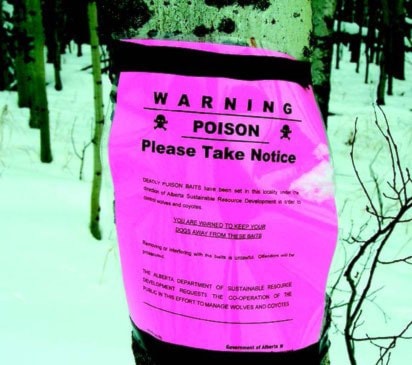Reducing the population of wolves and coyotes in the Rimbey area with the use of poison has a well-known biologist, birdwatcher and photographer up in arms and she is demanding some answers to what she believes is an inhumane practice.
Myrna Pearman, site service manager of Ellis Bird Farm, was surprised and disturbed to discover signs posted at the entrance of Town Creek Natural Area (south of Winfield) stating deadly poison baits had been set out to control coyotes and wolves in the area. The signs stated the poison had been set out under the direction of Alberta Sustainable Resource Development. The signs also stated removing or interfering with the baits is unlawful and offenders will be prosecuted.
Pearman, who has spent the majority of her career educating children and adults about nature and the importance of habitat conservation, was shocked.
Not one to rest on her laurels about an issue so dear to her heart, Pearman immediately contact Terry Krause, a regional planner in the East Central Region of Alberta Tourism, Parks & Recreation to express her concern.
However, Krause told her that the department not only did not use poison to control wolves and coyotes, they had no knowledge of the fact it was being used.
“No one in their department (was) aware that a warning sign had been posted in the Town Creek Natural Area,” she said.
Pearman said Krause later notified her he had learned no bait had been set up in the natural area but was set on adjacent Crown grazing lease lands where cattle losses had been reported. Signs had been posted in the
surrounding area. Pearman found that information of little comfort and again expressed her alarm and disgust about the practice in a letter to Diana McQueen, minister of Alberta Environment and Sustainable Resource Development.
“I find it unconscionable and offensive that Alberta still implements a draconian policy of poisoning predator mammals. Poison (especially strychnine and/or Compound 1080) is inhumane because it causes the animals a slow and agonizing death.
Equally disturbing is the fact that poison bait stations attract non-target species, resulting in the unnecessary suffering and death of other animals. Poison affects not only scavengers, but all species up the food chain suchas bald eagles, great horned owls and foxes.”
Pearman, who is a licensed bird bander, believes the government has a double standard regarding the preservation of wildlife.
“I am required to obtain permits and follow very strict regulations regarding the handling of wild birds so as to minimize disturbance and the risk of injury. Yet, it appears that your department can — with no apparent accountability and no communication with other departments — inflict suffering on wild animals and, by setting out bait stations that can potentially attract non-target animals, inexcusably waste our precious wildlife
resources,” she said.
The provincial government may want to consider The Wild Predator Loss, Control and Compensation Program adopted by British Columbia as an alternative, and much more humane way of controlling predation, she said.
“This program acknowledges that indiscriminate poisoning of wolves does not work and encourages manager to make the necessary effort to identify and remove only those individuals that have attacked livestock. The retention of non-offenders is important to long-term success because a preserved pack structure discourages new problem predators from moving into the territory.”
Daryl Hunt, president of Rimbey Fish and Game Association, was not aware of the signs being posted, adding that enforcing such a rule would not be within the fish and game association’s mandate.
However, he said poisoning may be the best way to rid the area of wolves and coyotes as shooting or trapping them may result in injury or death to the livestock being protected.
“They are illusive animals and when you get your sights on one, you may hit a cow instead. And trapping or snaring might not work either as a cow may step into the trap. There is a fine line. I don’t totally condemn
them (Alberta Sustainable Resource Development) at all.”
Hunt said fish and game association members go by the rule that big game and predators are “fair chase.”
“We pride ourselves on being able to take our rifles and hunt those animals. Period.”
A spokesperson from Alberta Sustainable Resource Development did not return calls from the Rimbey Review by press time.
Pearman has not yet received a response to her letter.
